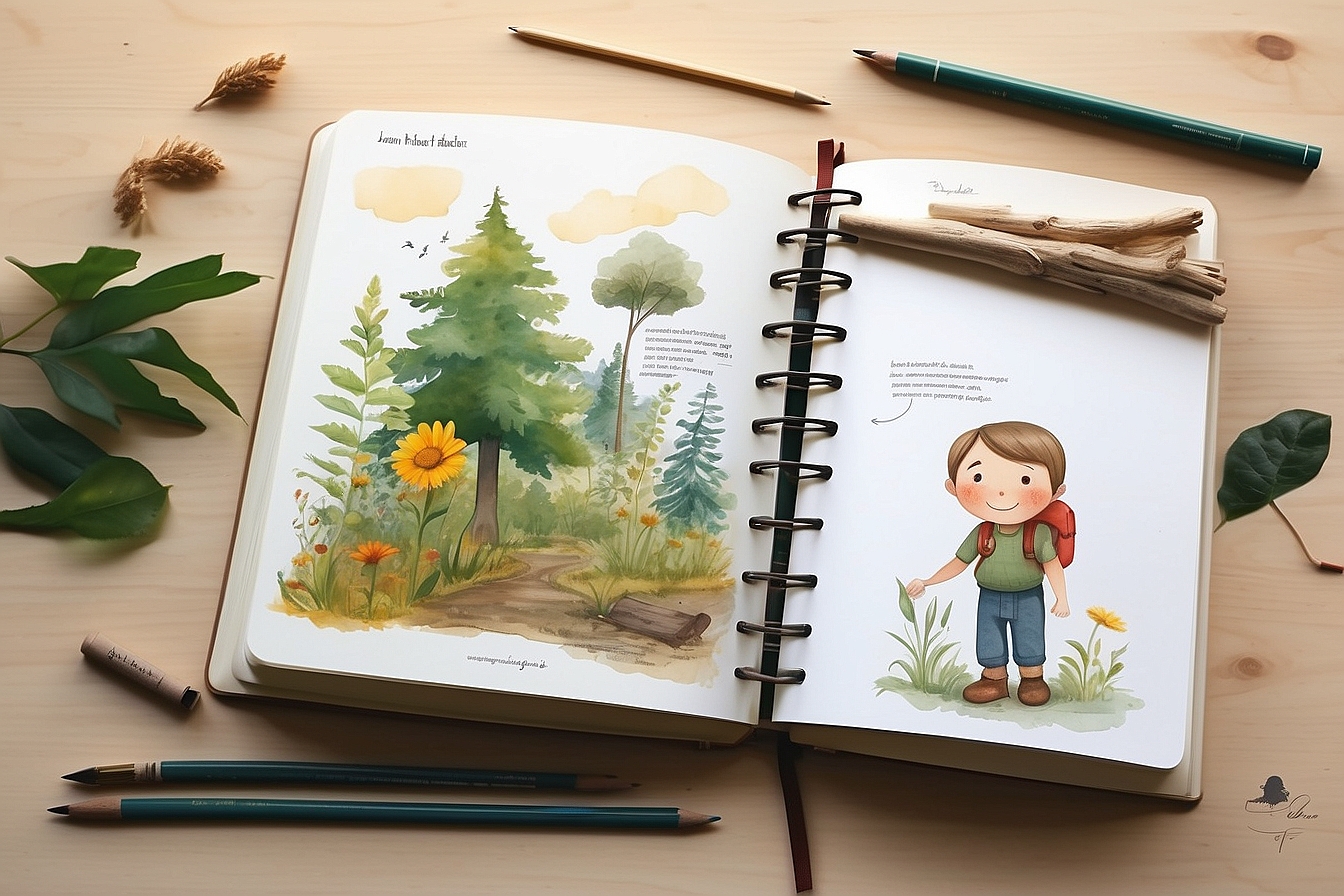
”To Journal or Not to Journal” – 8 Tremendous Benefits of Journaling for Kids
Today’s world is quite different from any other time in the past. It’s fast-paced, with technology dominating the scene and an unhealthy portion of social media and new ideologies emerging on the horizon. Controlling the ideas that get into the minds of the young ones is beyond impossible, which can jeopardise their mental health.
Journaling has become a modern method for one to let out some of their negative energy and undesired thoughts. Most psychiatrists and mental health professionals have been advising everyone to journal to let some steam out. Interestingly, this method is quite beneficial for adults and children alike. It’s a great way to spread your thoughts before you start using your reason.
But what’s journaling? Many kids are not that good at using their words to express their thoughts. That’s precisely when journaling comes in handy; it doesn’t have to be writing like a professional author or even writing at all. Drawing and sketching are considered a type of journaling that young children can resort to, yet the writing part may be more suitable for teenagers.
Many ideas and tips are available to help your young one’s journaling journey, so let’s get started.
What’s Journaling, And What Is It Used For?
Journal writing is a powerful tool where children use their words to describe their feelings. They may start by narrating how their day went, putting into words something that made them happy and other than saddened or angered them. This way, they feel like they can share the thoughts lingering in their minds that you don’t feel comfortable blurting out loud.
Journaling is also beneficial for parents to get to know their kids more and even bond. It gives them an insight into how their children react in certain situations, how they perceive the world around them, and what they expect.
The hardest part is to get your child to journal in the first place. Some children find the idea appealing right away, while others may resist. This requires you to be patient and never force it upon them, or else they’ll just hate it. On the other hand, the best part is that there are different techniques of journaling, including art and visual types, which can be more appealing to some.
9 Different Techniques of Journaling
Getting your children to get used to journaling can be challenging at first, for all children are not the same. Their characteristics can also play a significant role in this matter, as some children are more on the creative side than others. The best part is that journaling doesn’t always have to be one way; different techniques can be more appealing to children and young adults alike.
1. Gratitude Journaling
A gratitude journal is your daily diary where you put your positive thoughts into writing. You reflect on every single thing that makes you happy and satisfied. Even on bad days, there are good things that we tend to overlook, for we’re dwelling too much into our sadness. This technique lets you work harder on seeing the positive.
You get to write down at least three things you’re grateful for daily. This way, you won’t have to wait for Thanksgiving to come along for you to be thankful for your blessings. This daily habit will get your brain used to coping with bad events and still look on the bright side. You won’t be fragile with every single inconvenience that comes up.
2. Nature Journaling
The natural world around us plays a more vital role in our lives than you think it does. Those lush green trees, fresh air, and blue sky can elevate our moods when we feel down. Did we mention that animals are also part of nature? Yes, if you’re an animal lover, you should include those little creatures in your diary.
A nature journal is a free writing technique that allows you to stop, look around, and be present. Starting to take notice of your surrounding environment may let you realise that you walk through a beautiful road between your home and school every day. In this journaling technique, you write down the shape of the clouds, the weather condition, and the beautiful chirping sounds you hear.

3. Bullet Journaling
The bullet journal is often abbreviated to BuJo, and it’s one of the simplest techniques ever. This technique resembles the to-do list; you organise your thoughts in bullet points. It mainly focuses on jotting down important notes of tasks you want to get down and goals you want to achieve and keep track of.
It’s perfect for those overwhelmed by daily tasks and barely know where to start. This technique helps you in organising your thoughts in a neat matter and reduces anxiety. You can also use it as a weekly or monthly tracker of everything you want to do.
4. Art Journaling
Some people are not so big on words. They just don’t feel comfortable expressing themselves in an apparent and obvious way. In other words, they may shy away from writing their feelings or thoughts or just prefer using a different art form. Art journaling involves using colours, images, or patterns to express your thoughts and emotions.
It’s equivalent to writing but helps those more into the visual side. This technique is even more suitable for children who like to draw or paint. Not only does it give them the time to nourish their hobby, but it may also hone their drawing skills. It may be more effective for their creativity, and it’s considered a beneficial self-care tool.
5. Visual Journaling
You may think that visual and art journals are the same but are distinctive. Art journaling is about using patterns and colours to convey a meaningful message. However, visual journaling is a different story. This technique doesn’t have the same form; everyone’s visual journal is unique.
A visual journal is a mix between traditional writing and an art journal. It could be anything from meaningful writing to doodling, hand drawing, photographs clipped into the pages’ corners or even cutouts from books or magazines. It’s a colourful and diverse form that displays one’s emotions and thoughts in a creative way.
6. Free Writing
Free writing is the easiest and simplest technique to use when you’re looking for ways to pour down racing thoughts. It doesn’t require good writing skills; it just needs basic reading and writing abilities. This method helps many people calm down their overwhelming thoughts and release feelings they can’t bear.
However, free writing can also be about positive things. All you need to do is to set a timer, sit in a quiet place, and write down whatever pops into your mind. When the time’s up, you just stop. It doesn’t have to be neat and perfect; even if it looks messy and chaotic, it’s still free writing. This method is like a traditional version of texting your friend with unorganised thoughts, except that you use paper and pen, and that friend is yourself.

7. Unsent Letters
This journaling technique is rather powerful, where you can let out some negative thoughts and feelings and clear up some space in your head. Unsent letters are the method of writing down the words you wished you had said to someone but didn’t. This someone could be an old friend you grew apart from, a deceased family member, or an absent person.
Although it may feel hard and heavy at first, your writing will start flowing once you get started. You get to write everything you want to say to this person. This technique aims to get clarity and closure so you no longer keep waiting for an answer to your “whys”.
8. Dream Journaling
Our dreams are a reflection of our reality, thoughts, and feelings. They’re not just some made-up stories that trick our brains into believing. At least, that’s what scientists once declared. According to psychology, there’s a strong connection between our dreams and daily lives. Thus, dream journaling came into being to solve some of our mysteries.
No one can deny that dreams are still mysterious, with many questions surrounding them. However, this kind of journal requires you to write down your dreams, even the ones that feel or seem so mystical and non-sense. That way, our minds will start having an insight into how the brain receives information during the day and interprets it into dreams.
9. Worst Case Scenarios
Imagining the worst-case scenarios is a skill that many people tend to have, although they don’t want it. This is the result of a serious mental disorder like depression or anxiety. If you’re one of those people who always expect the worst to happen in order to be prepared, try out this journaling technique.
Worst-case scenarios journaling is when you write down the worst thing you’re afraid of happening. It’s a self-reminder that things don’t go south every time you expect them to. This can actually help in reducing your anxiety and calm your paranoid mind.
Top 8 Benefits of Daily Journals
Daily journals supposedly have a tremendous effect on young children. It should make them feel better and do well in life. Although it may seem trivial and simple, it can be more beneficial than you think. So, here are some fantastic benefits that you can reap from putting your thoughts and feelings into journals every day:
Betters Communication Skills
One thing that daily journals do is that they teach children to communicate through the usage of proper words. Eventually, the child develops better communication skills, more able to communicate their thoughts and feelings to those around them.
Lets Out Negative Thoughts and Emotions
Everybody has scary thoughts and negative emotions. The more you suppress them, the more they haunt you. One of the best ways you can get rid of unwanted thoughts is by talking about them. Even if you’re not the talkative type, writing down in your journal is a great way to let out some steam.
Improves Creativity
Journaling techniques are plentiful; no matter which one you pick up, they will do great wonders for your creative side. In fact, journaling aids in capturing the random thoughts and ideas that go through your mind every day, fostering better and clearer thinking, which is a key skill for creatives.

Enhances Writing Skills
Although using art is one journaling technique, writing is the core foundation of the whole thing. Its main purpose is to communicate through the usage of proper words. Eventually, this could significantly enhance your writing skills. Interestingly, it’s been a known fact throughout history that even the greatest of authors kept their journals with them wherever they went.
Boosts Memory
Journaling is all about using their cognitive skills and even putting them to the best use. It’s one of the tools that make your brain work at full capacity, enhancing your comprehension and keeping your brain in good shape. When your brain is significantly active, your memory works much better, and you’re less likely to get brain disorders in the future.
Increases Awareness and Emotional Intelligence
Mental health is no joke; it takes a considerable toll on people’s life, affecting almost every aspect. Lack of self-awareness and detachment from your inner self is one reason people end up anxious and depressed. This is another area where daily journals can help you. It will increase your awareness of your surroundings and make you more in touch with your feelings. This can also help in keeping your thoughts organised.
Simple Tips for Children
Now that you’ve learnt about the different techniques of journaling and the tremendous benefits they can have on your life, it’s time to hear some little tips. These tips will help you go forward with your journaling journey and become the person you aspire to be. So, let’s get started:
Ignore Inner Critic
The first and foremost tip is to ignore that critical voice inside your head. Constructive criticism is essential in moving forward and improving, but that’s what we’re discussing here. We’re talking about your inner critic that says you’re not doing it right or should stop.
Because, guess what?, it won’t mute until you push through and try to silence it yourself. Know that starting journaling doesn’t have to be about perfect writing or impressive drawings. It’s about taking the first step towards finding your inner voice and empowering it.
Change Your Styles
Picking up a specific technique doesn’t mean you have to stick with it for eternity. If you think your chosen method is not working for you, ditch it and pick another one. It’s essential to keep things simple and interesting.
Besides, you don’t have to devote yourself to a single style. You can keep changing your styles over and over until you find the one that appeals to you. That’s the thing about journaling it doesn’t have to be perfect, but it has to be fit for you. So keep digging until you find your treasure.
Get Feedback
There’s no wrong or right when it comes to sharing your thoughts and feelings. Some people prefer keeping things private, while others find it better to communicate their thoughts with someone. If you fall into the latter, don’t stir away from sharing your journals with someone you trust.
Even more, you can ask for feedback. This can help you focus more on significant parts of your experience that you may have missed. More importantly, sharing your experience with others can help them better understand you and even communicate on a deeper level.
So, now is the time you choose your favourite technique and start journaling away your worries. Give the process the time it needs to help you become a better version of yourself and better understand the world around you.
Why not subscribe to our LearningMole Library for as little as £1.99 per month to access over 3000 fun educational videos.


Leave a Reply